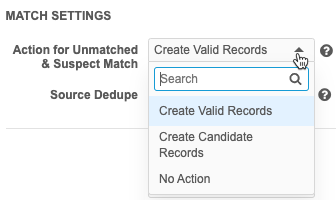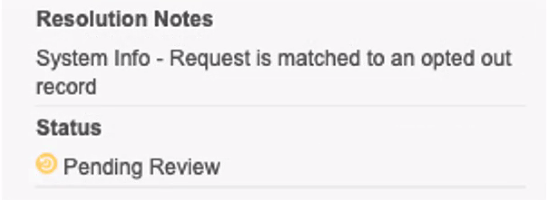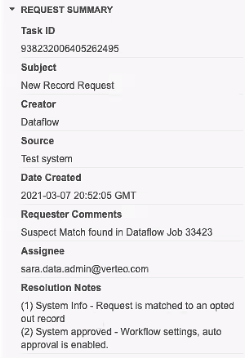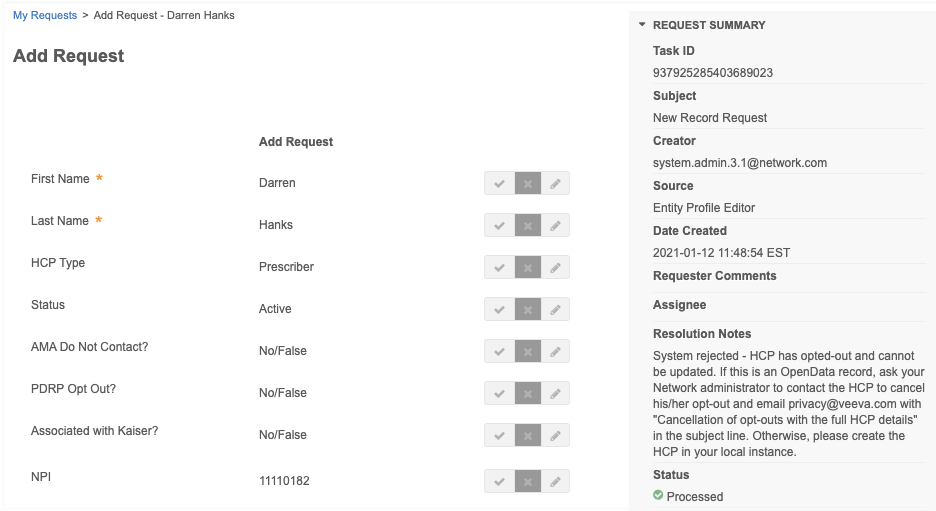Opt out matching settings
DM
Administrators can include opted-out HCP records in matching for incoming records from add requests and source subscriptions. By default, opted out records are excluded from matching.
Supported records
-
Records that you have opted out in your Network instance (customer opt outs)
-
Records that have been opted out from Veeva OpenData and have previously been downloaded to your Network instance.
You can determine the records to include by country.

Configure the opt out match settings
Administrators can manage the match behavior for opted out records for their Network instance.
To configure match behavior:
-
In the Admin console, click Settings > Opt Out Matching Settings.
The configuration page contains options for Customer and OpenData opt outs.
-
In the Customer Opt Outs in your instance section, choose an option:
-
Exclude OpenData opted out records from matching (default) - This is the default setting.
-
Include OpenData opted out records in matching - Allow records that you have opted out to be included in the matching process for add requests and source subscriptions.
These settings apply to all countries unless you add a country exception.
Note: If this section does not display, the
data_privacy_opt_out__cfield is not enabled or the Candidate Records feature is not enabled, or both. These must be enabled to match against customer opted-out records. -
-
In the OpenData Opt Outs in your instance section, choose an option:
-
Exclude OpenData opted out records from matching - This is the default setting and represents the current behavior (no matching).
-
Include OpenData opted out records in matching - Allow opted-out records to be included in the matching process.
If you select this option, choose one of the following:
-
Review new incoming records that match OpenData opt outs - Incoming records will be sent to the local inbox for review. If approved, they become valid and active locally managed records. Custom keys will be assigned to the records, as usual.
The record will include feedback that it initially matched with an opted out record.
- Reject new incoming records that match OpenData opt outs - Incoming records that match are rejected. On the rejected add request or source subscription job details, feedback displays so you know that the incoming record matched with an already downloaded OpenData opted out record.
-
These settings apply to all countries unless you add a country exception.
-
- To define a different option for specific countries, click Add Exception.
- Save your changes.
Match to customer opted out records
You can opt out any HCP record (local, Veeva OpenData, and third party records) in your Network instance. Customer opted out records are visible in your Network instance if your HCP Opt Out Visibility data visibility profile permission is set to True. Incoming records can be merged with customer opted out records if a match is found.
Match options
-
Exclude - When you choose not to match with opted-out records, the present behavior for incoming unmatched records occurs (a valid record, a candidate record, or no record is created).
Duplicate records could be created because the add request or source subscription cannot find the record that it should be matched to.
-
Include - The match process considers opted out records.
-
If a match is not found, the present behavior for incoming unmatched records occurs (a valid record, a candidate record, or no record is created).
-
If the incoming record matches, the outcome depends on the type of match that is found.
-
Summary of behavior for customer opt outs
| Match Option | Behavior | |
|---|---|---|
| Add Requests | Exclude | Duplicate records could be created. |
| Include | Add requests can become change requests or can be created as candidate records and included in suspect match tasks. | |
| Source subscriptions | Exclude | Duplicate records could be created. |
| Include | Incoming records can match and update records or can be created as candidate records and included in suspect match tasks. |
The result of the matching process when you include opted-out records can depend on the settings that you define in the source subscription.

In this example, the source subscription setting Action for Unmatched & Suspect Match was set to Create Valid Records. The match rules were also updated to force suspect match tasks.
When the job ran, one local record was created as well as a suspect match. Notice that the count in the Added Locally column is two (2) for this reason.

If the Action for Unmatched & Suspect Match setting was set to Create Candidate Records, the two new records would be candidate records. If the setting was set to No Action, no records would have been created.
Matching to OpenData opted out records
When records that you have previously downloaded are opted out in Veeva OpenData, they can no longer be accessed in your Network instance. Using this feature, incoming records in add requests and source subscriptions can still match to the opted out records because the records remain in Network, even though they're not visible.
If a match is found , the incoming record cannot be merged with the opted-out OpenData record, but a new locally managed record can be created.
Summary of behavior for OpenData opt outs
| Match Option | Behavior | ||
|---|---|---|---|
| Add Requests | Exclude | Customer cannot retain a copy of an opt out | |
| Include - Reject | Record matches and is automatically rejected with a note. | ||
| Include - Review | Add request is sent to the local inbox with a note. | ||
| Source subscriptions | Exclude | Duplicate records could be created. | |
| Include - Reject | Record matches and is automatically rejected with a note. | ||
| Include - Review | Add request is sent to the local inbox with a note. |
Match options
You can choose one of these options to match to OpenData opted out records:
-
Exclude - When the matching process does not occur, the present behavior for incoming unmatched records occurs (a valid record, a candidate record, or no record is created).
Duplicate records could be created because the add request or source subscription cannot find the record that it should be matched to.
-
Include - The match process will consider opted-out records.
Behavior for including opted out records
Match type Outcome No match is found The present behavior for incoming unmatched records occurs (a valid record, a candidate record, or no record is created). Key matches If an incoming record matches using custom keys or VIDs, the opted out record is updated with the data from the incoming record (present behavior). ACT and ASK matches When strong matches or fuzzy matches are found, Network recognizes that the match is with an opted out record and will not update it with the incoming record.
The option that you choose in the configuration (Reject or Review) determines what happens to the incoming record.
Reject - If a match is found, the incoming record is auto-rejected and discarded.
Review - When a match is found, an add request is routed to the local inbox. If the add request is accepted, a locally managed record is created.
Considerations for source subscriptions
When opted out records are included in matching and an incoming record matches with two records, the record with the lowest VID is matched, regardless of whether the records are opted out or not. This is existing match behavior
For example, if an incoming record matches to both a downloaded opted-out OpenData record and an existing record that is not opted out, the record with the lowest VID is matched.
Including opted out records
When you choose to include opted out records in matching, there are two options:
-
Reject new incoming records that match OpenData opt outs
-
Review new incoming records that match OpenData opt outs
Reject matches
If you choose this option and a match is found, the incoming record is auto-rejected and discarded.
Note: Because ASK and ACT matches are treated the same, some records might really be duplicates of opted out records, while other records are not. Rejecting records could result in the loss of data for records that are not actually a duplicate of the opted out record.
-
Add requests - A resolution note displays in the request so the user knows why the request was rejected.
-
Source subscriptions - If you reject matches in source subscriptions, the rejected matches are identified in the job error log, job details, and the inbox.
 Job error log
Job error log
A job warning displays in the Job Error Log so you can identify the record that was not processed.

The VID displays, but opted-out OpenData records are not accessible in the Network UI. In this example, TEST1:12185|TEST12 is the key for the record from the incoming file. TEST1:2 means that rejected record was in the second row of the feed called TEST1.
 Job Details page
Job Details page
The Job Summary table displays a count of the matches that were rejected in the Rejected column.

 Inbox
Inbox
Source subscription jobs with the rejected matches are listed in the inbox with Job Warnings.

Review matches
If you choose this option and a match is found, an add request is routed to the local inbox. If the add request is accepted, a locally managed record is created.
Note: An ASK match cannot be created as a suspect match task because the opted-out OpenData record is not visible in Network.
The resolution note explains that the record matched to an opted out record.
-
Add requests - If the original add request was created by a Data Steward and it matches to an opted out record, the request is automatically approved, as usual. If it was created by another user, Data Stewards can review and process the request.

-
Source subscriptions - Any matches found for opted-out OpenData records are identified in the Job Details, match log and on the resulting add requests.
 Job Details page
Job Details page
The Match Summary table displays a count and percentage of matches in the ACT Matches column, but the Job Result Summary table displays only zeros (0).
Note: The percentages may not equal 100 due to rounding.

 Match log
Match log
Any matches display in the match log because you've chosen to review the matches. It also displays because you can't match to an already downloaded opted-out OpenData record because that record isn't accessible in your Network instance.
The Match Id and Numeric Match ID columns display the opted-out OpenData record that matched to the incoming record. The opted-out record cannot be accessed in the Network UI, but you can report on the VID for more details.

 Inbox
Inbox
Because the match to an opted-out OpenData record isn't possible, an add request is created to potentially add a local record.
The Requester Comments in the add request explain that the record was matched in a source subscription.
The Resolution Notes identify that the request matched to an opted-out record and that custom key values are being automatically approved.

Note: Add requests will follow the rules you have defined in your workflow settings. For example, add requests from matched records will be automatically approved if you have set your workflow setting to do this for new customer owned records.
-
